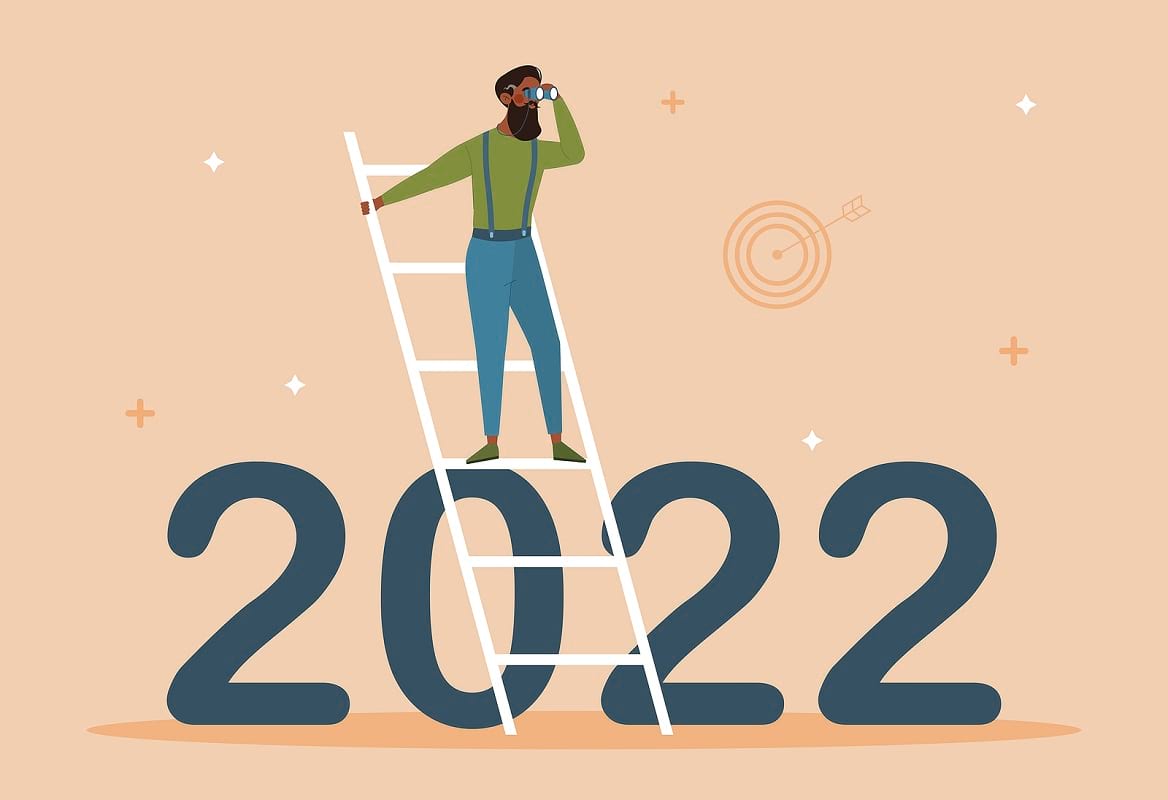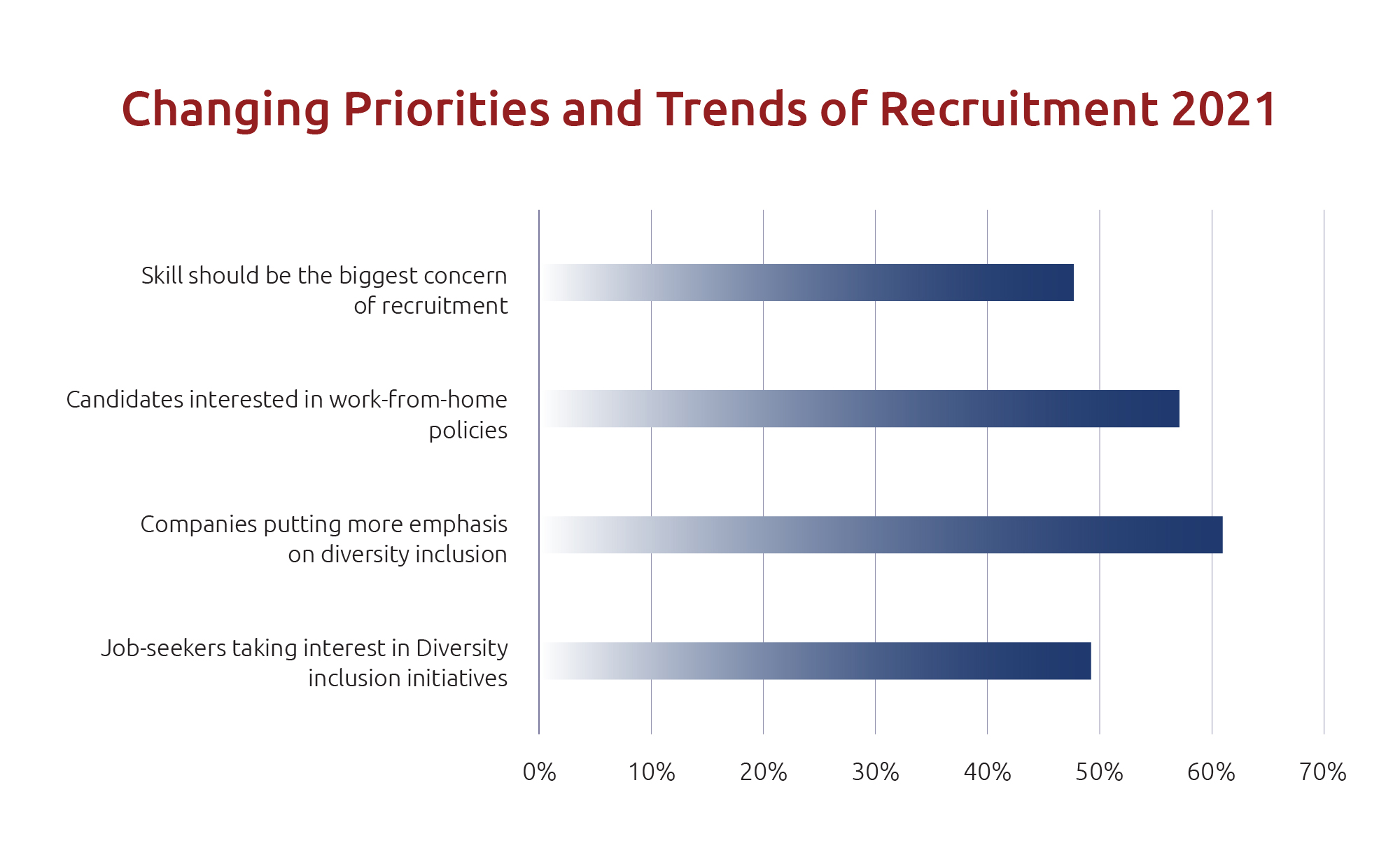Top Recruitment Lessons from 2021 and Trends for 2022

There has never been a year as thought-provoking as 2021 for recruiters worldwide. Last year, the pandemic caused severe setbacks, but it also came with a silver lining – a great learning curve for talent acquisition teams.
Besides these jobs data revelations, the recent technological advancements are continuously forcing workplaces to operate and adopt a modern approach to meet remote working needs.
Last year when the pandemic broke, the industry had to adjust its priorities. According to the 2021 Recruiter Nation Report , more emphasis was placed on diversity inclusion, and the ability to work from home while hiring for the right skillset became the biggest concern for recruiters.

Source:Data is from JobVite Report
To attract high-quality employees, talent acquisition teams use the following techniques to adjust to these changing trends.
Lessons and Practices From 2021
More Emphasis on Employee Value Proposition (EVP)
The changing times paired with the pandemic have compelled organizations to focus on employee branding. Organizations that emphasize EVP have been more successful at attracting and retaining top talent. There are many different new-age initiatives organizations can leverage to optimize EVP.
Social media channels are not just for making new friends. They are also a helpful recruiting tool to target new candidates and initiate conversations. Organizations can showcase more of the company culture to prospective employees through social channels. Over 40M people use LinkedIn for their job search every week, and therefore LinkedIn targeting is an effective tool for recruiters to reach candidates from all over the world.
Prospective employees don’t just want to read about a company’s culture and the environment – they want to see it in action. The careers page should reflect your organization’s journey and inspire candidates to be a part of it. The page should feature videos and testimonies from current employees to resonate with top talent.
Integrating Automation Into the HR Processes
One 2020 survey in the US reports 69% of HR executives have considered expanding or replacing their current HR systems with an automated system. A PWC survey also says that 74% expect to increase HR technology spending.
Two solutions that have helped organizations are AI-enabled and other automation software like Application Tracking System (ATS), Human Resource Information System (HRIS), etc. However, we anticipate seeing more automation implemented in HR activities apart from application tracking like payroll management, tax filing, etc.
These processes might seem easy on the outside but take up a lot of time. Once automated, the tool will integrate all the employee databases, and it would be much easier for HR to keep track of all the processes end-to-end. The best part will be that recruiters can track all the processes from a single interface.
Giving More Importance to Talent Pool Management
Human resource departments have been using the talent pool system for a long time, but its value increased last year. Numerous organizations turned towards their talent pool for recruiting high-quality candidates to meet the rising skill-shortage throughout the pandemic. By offering new vacancies to the existing workforce, HR increased company loyalty. Other benefits realized include:
- Reduced recruitment costs
- Shortened end-to-end hiring cycle
- Optimum utilization of the existing workforce
Recruitment in 2022 and Beyond
The pandemic has created a lasting impact on businesses. Organizations have realized that they need the right set of skills and technological advancements to fill the recruitment gaps. Therefore, to continue to attract top talent, below are the trends we believe are here to stay:
Permanent Provision of Remote Work
The pandemic taught employees and employers that it could complete many tasks remotely. This not only has become important to employees but has also helped employers cut down on costs. 55% of employees prefer remote work at least three days a week, and even more, organizations are planning to change their working model by incorporating remote work every week.
Internal Hiring on the Rise
According to LinkedIn, there has been a 20% increase in internal mobility since the pandemic hit. Recruiters have realized that the existing workforce holds tremendous potential to fulfill the ongoing vacancies. This will further increase the emphasis on upskilling and reskilling activities and strengthen employee engagement.
Virtual Hiring is Here to Stay
During the pandemic, large multinational and mid-level organizations switched to the virtual hiring process. Virtual and automated interviews can offer accelerated timelines and allow employees and employers to participate in a setting in which they feel more comfortable. However, despite moving to virtual, talent acquisition teams and recruiters must continue to put people first.
Leveraging Social Media Channels to Build Branding
Organizations leverage the top social media channels to build a transparent and well-known reputation and brand. On popular platforms like LinkedIn and Glassdoor, organizations are also investing in building interactive company profiles on Twitter, Instagram, and more. Thus, we expect organizations to be more creative and interactive with social branding in 2022.
Modeling the Recruitment Process Per Gen-Z Requirements
The next generation is entering the workforce, and therefore, recruiters need to prioritize their strategies for this target demographic. To attract top talent, recruiters should continue to invest in tools to automate and digitize their recruitment processes. Additionally, they will need to showcase their company culture and how they are unique in the market.
Dealing with the Talent Crunch and Great Resignation
We have seen increased demand for talent for many new and emerging technologies amid the pandemic. As a result, there is a severe gap between demand and supply. Further, remote working has allowed employees to re-evaluate their career paths and alternate options.
A record-breaking number of resignations has accompanied this since the pandemic. According to a study, the rate of resignation is highest among mid-career employees. IT, technology, and healthcare industries have seen the highest resignation rates.
But recruiters can address this with a data-driven approach accompanied by an upskilling and reskilling strategy. Managers should also get trained to manage a virtual workforce. Conference rooms will need more investment to improve their virtual connectivity. Recruiters can leverage these changes once implemented to attract new candidates.
Since the pandemic, talent acquisition teams and recruiters have faced many challenges, which required significant adaption to the new norm. While 2021 had many changes and lessons learned, we anticipate 2022 to include exciting transformations and technological advancements. Therefore, it is essential to look at your processes and identify where you can optimize them to recruit top talent.
Ajay Kaul is the managing partner atAgreeYa Solutions.
Get the top recruiting news and insights delivered to your inbox every week. Sign up for the Recruiter Today newsletter.

